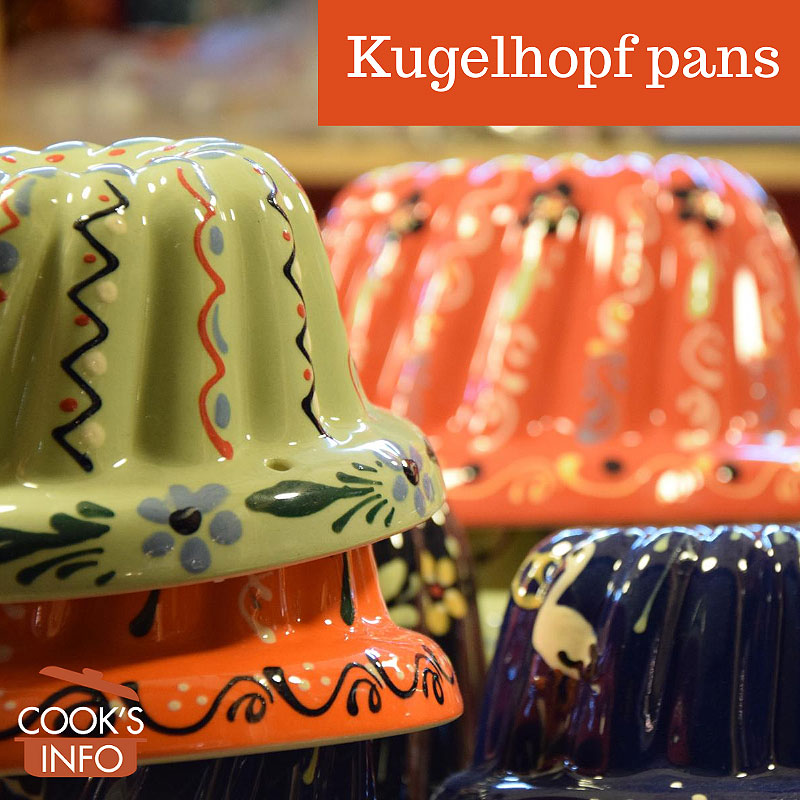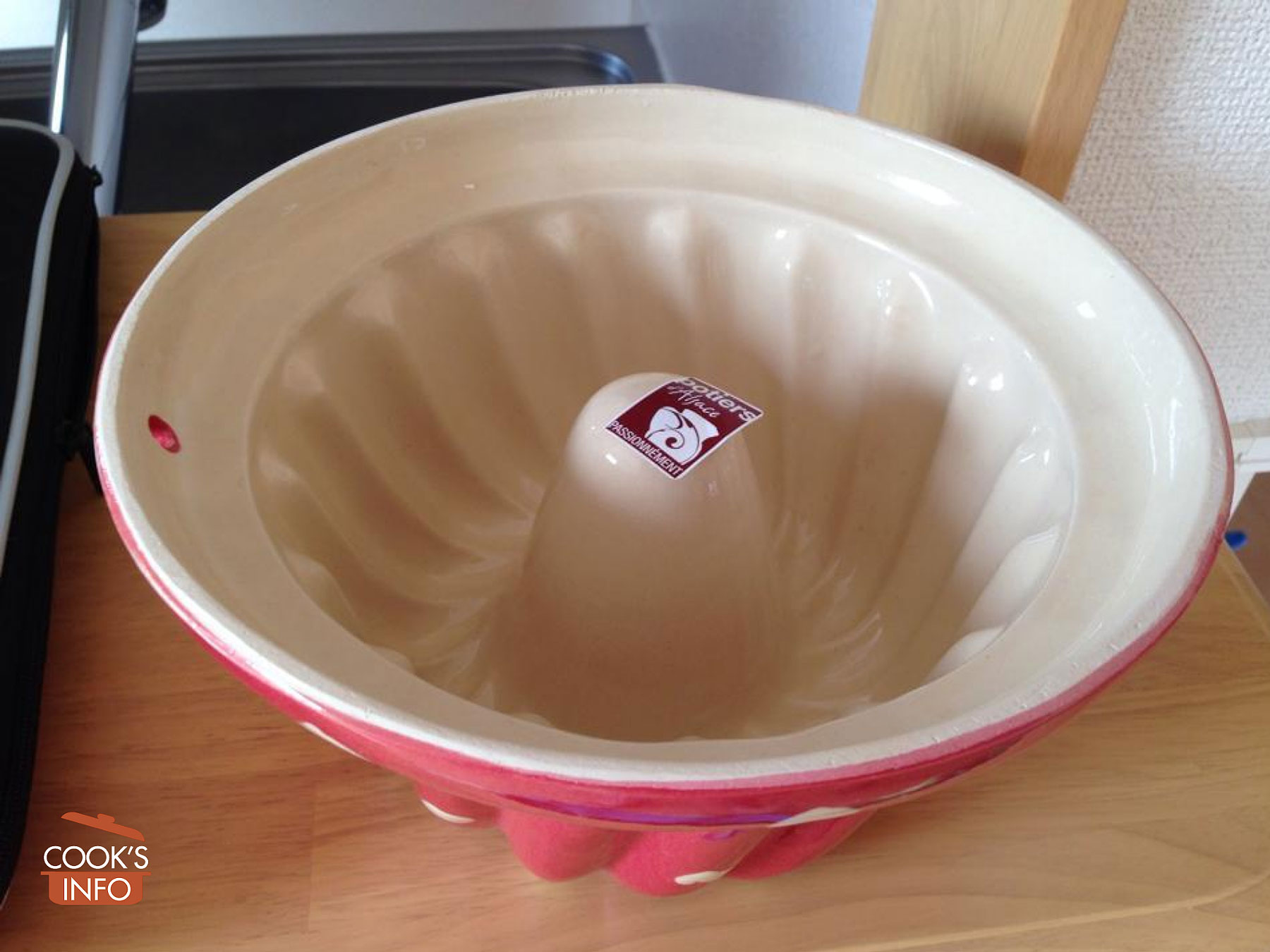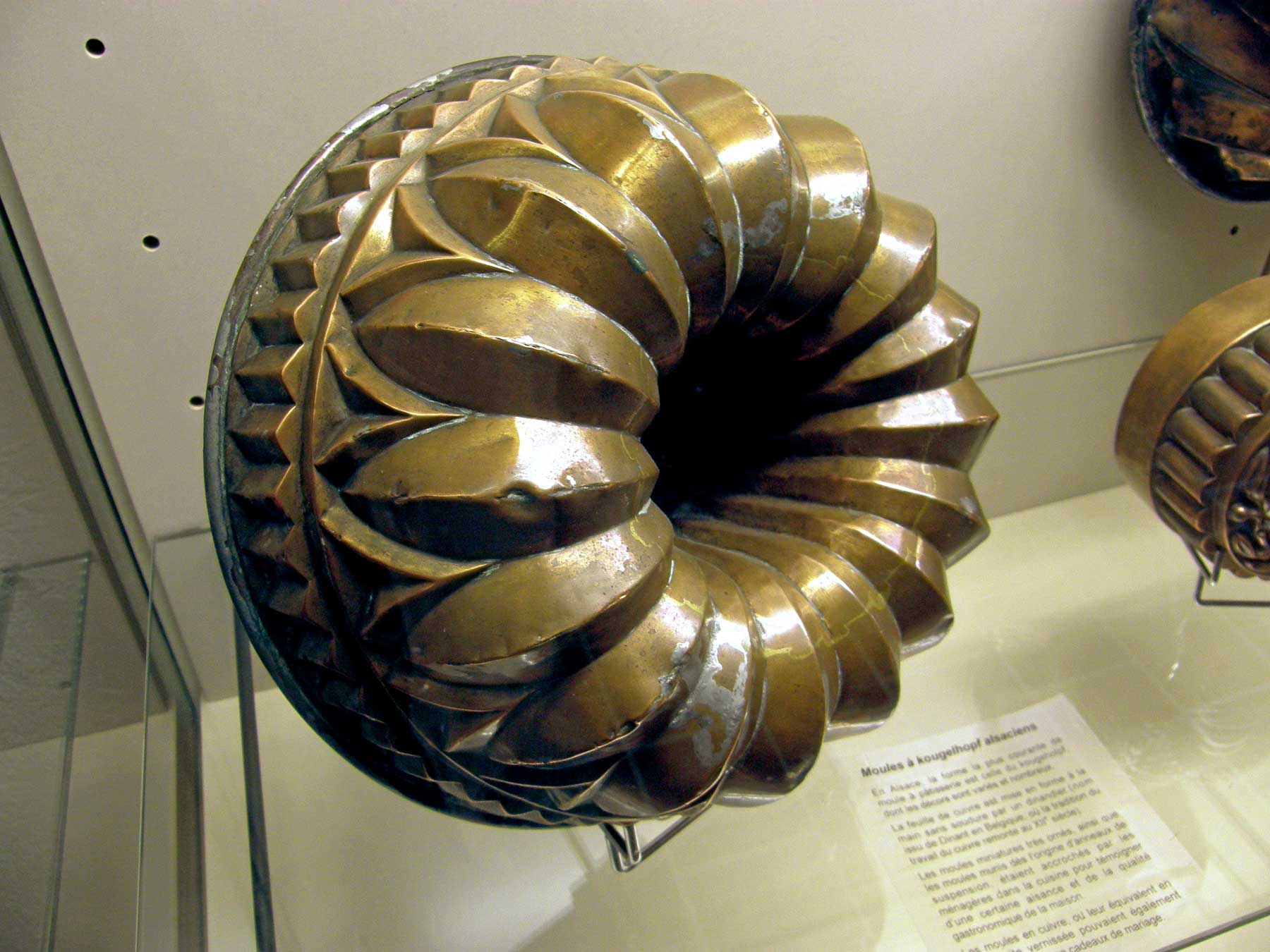
Kugelhopf pans. 0x010C / wikimedia / 2014 / CC BY-SA 4.0
Kugelhopf pans (aka Gugelhupf pans) are essentially the same as fluted tube pans. They are used to make kugelhopf cakes.
The Penguin Companion to Food says:
“The identifying characteristic of kugelhopf is its tall ring shape. This is derived from the mould in which it is baked, round and deep, with a central funnel, and fluted with decorative swirls.” [1]Mason, Laura. In: The Penguin Companion to Food. London: The Penguin Group, 2002. Page 524.
Larousse Gastronomique (1988 edition) describes the design as a “high crownlike mould”. [2]Lang, Jennifer Harvey, ed. Larousse Gastronomique. New York: Crown Publishers. English edition 1988. Page 599. Others describe the mould as “turban shaped.” [3]”One story says it originated in Vienna when the Hapsburg forces defeated the Turks at the city’s gates. In celebration, Viennese bakers supposedly made a cake in the shape of the sultan’s turban.” — Sheraton, Mimi. In Alsace, a Pastry With Heart and History. New York: New York Times. 23 December 1998. Section F, Page 3, col. 1.
The tube in the middle allows heat to penetrate cake from the centre in. The fluted design of the edges allows for more surface of the cake to get browned, while also allowing more heat to penetrate into the cake for better cooking.
The pans come in various sizes, even mini-sizes.
They will be made of glazed clay or ceramic, heavy-gauge steel, aluminum, or non-stick metal.
Sharon Hudgins surveyed the range of pans for the Gastronomica journal:
“These cakes can be baked in ceramic, copper, tin, cast iron, or aluminum molds, but most Alsatian cooks favor the earthenware molds that have been handmade for several centuries in the local pottery village of Soufflenheim. Purely functional ceramic molds (considered to be the best for baking Kugelhopf) are glazed only on the inside; antique molds of this type have interiors glazed in various shades of brown, green, ocher, ivory, or terra cotta. Many contemporary molds, which double as decorative items in the kitchen, have plain ocher interiors, with the outside glazed in a shade of blue, brown, green, yellow, or sometimes even red or pink, decorated with rustic, hand-painted, multicolored floral motifs. Sizes range from miniature molds only two inches in diameter to family-size molds measuring ten or more inches across the top. With proper care, these earthenware molds become increasingly well seasoned with butter during each use, rendering them practically nonstick and subtly enhancing the flavor of each successive cake.” [4]Hudgins, Sharon. Alsatian kugelhopf: A cake for all seasons. University of California: Gastronomica. Vol. 10, No. 4, pp 62-66. ISSN 1529-3262. 2010. Page 63.
Writing for the New York Times, Mimi Sheraton said:
“…most bakers agree that for the driest, smoothest crust and best-textured result, the baking mold should be made of terra cotta glazed only on the inside. Throughout Alsace, souvenir and kitchenware shops display every size and color of kugelhopf mold, the most basic being the plain earthy brown and the fanciest having richly colored glazes and hand-painted flowers or other kitschy decorations. These days, metal molds are widely used, especially because terra cotta is so fragile.” [5]Sheraton, Mimi. In Alsace.

Interior shot of kugelhopf pan. ©Paul Chamness Iida / 2018
History Notes
The pans don’t actually date that far back in time. Gastronomica Journal says,
“the oldest Kugelhopf cake molds found in Alsace date from only the eighteenth century.” [6]Hudgins, Sharon. Alsatian kugelhopf: A cake for all seasons. Page 62.
Early versions were ceramic and earthenware. In the 1880s, they were made of tin-lined copper. As the name would imply, they were popular in German speaking regions of Europe, as well as other parts of central Europe.
They were introduced commercially into America under the trademarked name of Bundt pans.
Language notes
For a discussion of the origin of the name kugelhopf, see Kugelhopf cakes: Language notes.

Metal kugelhopf pan, Alsace. Bourrichon / wikimedia / 2008 / CC BY-SA 3.0
References
| ↑1 | Mason, Laura. In: The Penguin Companion to Food. London: The Penguin Group, 2002. Page 524. |
|---|---|
| ↑2 | Lang, Jennifer Harvey, ed. Larousse Gastronomique. New York: Crown Publishers. English edition 1988. Page 599. |
| ↑3 | ”One story says it originated in Vienna when the Hapsburg forces defeated the Turks at the city’s gates. In celebration, Viennese bakers supposedly made a cake in the shape of the sultan’s turban.” — Sheraton, Mimi. In Alsace, a Pastry With Heart and History. New York: New York Times. 23 December 1998. Section F, Page 3, col. 1. |
| ↑4 | Hudgins, Sharon. Alsatian kugelhopf: A cake for all seasons. University of California: Gastronomica. Vol. 10, No. 4, pp 62-66. ISSN 1529-3262. 2010. Page 63. |
| ↑5 | Sheraton, Mimi. In Alsace. |
| ↑6 | Hudgins, Sharon. Alsatian kugelhopf: A cake for all seasons. Page 62. |

